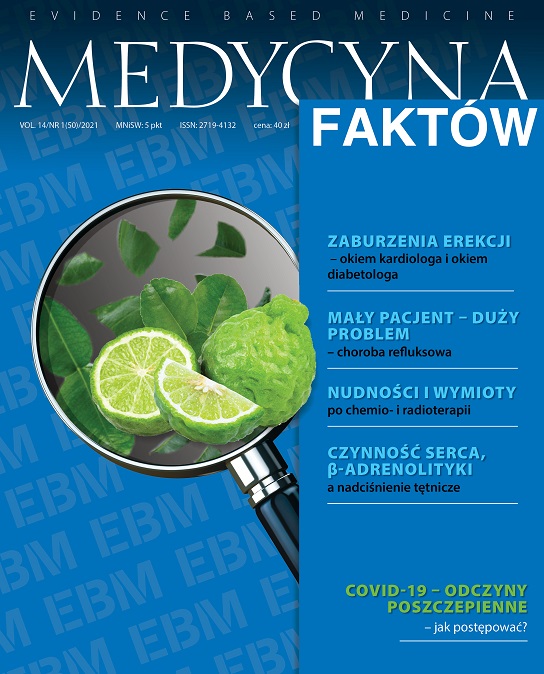Zaburzenia erekcji – punkt widzenia kardiologa Artykuł przeglądowy
##plugins.themes.bootstrap3.article.main##
Abstrakt
Schorzenia układu sercowo-naczyniowego są powszechnym zjawiskiem, podobnie jak: otyłość, nadciśnienie tętnicze czy cukrzyca. Wpływają one negatywnie na wszystkie sfery naszego życia, w tym również na nasze życie seksualne. Obecnie najlepiej poznane są wzajemne zależności pomiędzy występowaniem zaburzeń erekcji i chorób układu sercowo-naczyniowego. Zaburzenia erekcji mogą być nie tylko powikłaniem chorób układu sercowo-naczyniowego, lecz także ich wczesnym rewelatorem. Mogą być jednak także działaniem niepożądanym niektórych leków kardiologicznych. Tymi zagadnieniami zajmuje się kardioseksuologia. Być może jednak jeszcze ważniejszym zagadnieniem jest bezpieczeństwo leczenia zaburzeń erekcji u pacjentów kardiologicznych.
##plugins.themes.bootstrap3.article.details##
Copyright © by Medical Education. All rights reserved.
Bibliografia
2. Eardley I. The incidence, prevalence and natural history of erectile dysfunction. Sex Med Rev. 2013; 1: 13-6.
3. Braun M, Wassmer G, Klotz T et al. Epidemiology of erectile dysfunction. Results of the Cologne Male Survey. Int J Impot Res. 2000; 12: 305-11.
4. O’Donnell AB, Araujo AB, McKinlay JB. The health of normally aging men: The Massachusetts Male Aging Study (1987-2004). Exp Gerontol. 2004; 39: 975-84.
5. Thompson IM, Tangen CM, Goodman PJ et al. Erectile dysfunction and subsequent cardiovascular disease. JAMA. 2005; 294: 2996-3002.
6. Hodges LD, Kirby M, Solanki J et al. The temporal relationship between erectile dysfunction and cardiovascular disease. Int J Clin Pract. 2007; 61: 2019-25.
7. Dong JY, Zhang YH, Qin LQ. Erectile dysfunction and risk of cardiovascular disease: meta-analysis of prospective cohort studies. J Am Coll Cardiol. 2011; 58: 1378-85.
8. Gong B, Ma M, Xie W et al. Direct comparison of tadalafil with sildenafil for the treatment of erectile dysfunction: a systematic review and meta‑analysis. Int Urol Nephrol. 2017; 49: 1731-40. http://doi.org/10.1007/s11255-017-1644-5.
9. Forgue ST, Patterson BE, Bedding AW et al. Tadalafil pharmacokinetics in healthy subjects. Br J Clin Pharmacol. 2006; 61(3): 280‐8. http://doi.org/10.1111/j.1365-2125.2005.02553.x.
10. Young JM, Feldman RA, Auerbach SM et al. Tadalafil improved erectile function at twenty-four and thirty-six hours after dosing in men with erectile dysfunction: US trial. J Androl. 2005; 26(3): 310‐8. http://doi.org/10.2164/jandrol.04126.
11. Washington SL 3rd, Shindel AW. A once-daily dose of tadalafil for erectile dysfunction: compliance and efficacy. Drug Des Devel Ther. 2010; 4: 159‐71. http://doi.org/10.2147/dddt.s9067.
12. Kloner RA, Mitchell M, Emmick JT. Cardiovascular effects of tadalafil in patients on common antihypertensive therapies. Am J Cardiol. 2003; 92(9A): 47M‐57M. http://doi.org/10.1016/s0002-9149(03)00075-4.
13. Kloner RA, Mitchell M, Emmick JT. Cardiovascular effects of tadalafil. Am J Cardiol. 2003; 92(9A): 37M‐46M. http://doi.org/10.1016/s0002-9149(03)00074-2.
14. Bocchio M, Pelliccione F, Passaquale G et al. Inhibition of phosphodiesterase type 5 with tadalafil is associated to an improved activity of circulating angiogenic cells in men with cardiovascular risk factors and erectile dysfunction. Atherosclerosis. 2008; 196(1): 313‐9. http://doi.org/10.1016/j.atherosclerosis.2006.09.035.
15. Rosano GM, Aversa A, Vitale C et al. Chronic treatment with tadalafil improves endothelial function in men with increased cardiovascular risk. Eur Urol. 2005; 47(2): 214‐22. http://doi.org/10.1016/j.eururo.2004.10.002.
16. Manolis AJ, Doumas M, Viigimaa M et al. Hypertension and sexual dysfunction. Choroby Serca i Naczyń. 2007; 4: 65-9.
17. Jackson G, Rosen RC, Kloner RA et al. The second Princeton consensus on sexual dysfunction and cardiac risk: new guidelines for sexual medicine. J Sex Med. 2006; 3: 28-3.
